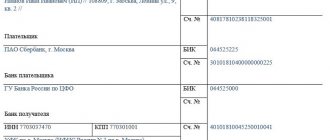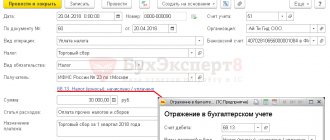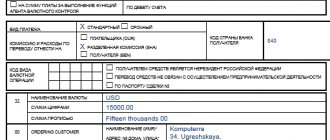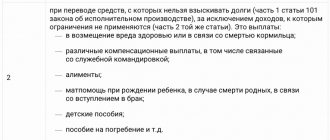Normative base
Decree of the Government of the Russian Federation No. 841 of July 18, 1996 “On the List of types of wages and other income from which alimony for minor children is withheld”
Federal Law No. 229-FZ of October 2, 2007 “On enforcement proceedings”
Directive of the Bank of Russia No. 5286-U dated October 14, 2019 “On the procedure for indicating the code of the type of income in orders for the transfer of funds”
Information letter of the Bank of Russia dated February 27, 2020 N IN-05-45/10 “On indicating the amount collected in the settlement document”
What has changed since June 1, 2021
From June 1, 2021, by the instructions of the Central Bank of Russia No. 5286-U, mandatory codes have been introduced that are indicated when issuing payment orders to individuals. The encoding is entered in field 20 “Name. pl.” and is intended to separate payments to citizens who can be levied under enforcement proceedings and who cannot.
There are only three codes:
1 - income that bailiffs have the right to seize, but subject to restrictions: wages, vacation pay, disability benefits;
2 - payments for which recovery is not applied: alimony, child benefits (Article 101 229-FZ of October 2, 2007);
3 – compensation for harm to health.
When transferring child support withheld from an employee, indicate the second income code in the payment order for alimony in field 20.
How to fill out a payment order?
The payment document is always filled out according to certain rules.
The order must include the following information:
- document name and number. The data is indicated at the top and is created automatically if the previous order was saved after creation;
- current date of order generation;
- type of payment – electronic;
- personal data of the payer, including full name, details and name of the bank, OKPO, as well as personal current account;
- personal data of the recipient, including full name, details and name of the banking institution, OKPO, as well as the recipient’s individual account;
- the amount that must be indicated in numbers and words;
- payment code (code 01 is used for alimony transfers);
- The order of deduction is the sequence of payment for the order (number one is selected). Alimony is always paid first. This point is clarified by Article 855 of the Civil Code of the Russian Federation;
- purpose of the transfer – payment of child support obligations (full name, children, date and grounds for collection);
- personal signature of the payer.
Expert opinion
Maria Lokshina
Family law expert since 2010
It should be noted that every incorrectly completed bank document will not be posted, therefore, the funds will not be credited to the recipient’s account in a timely manner. In such cases, employees of the financial organization inform the client about the presence of errors in the document. After this, you should contact the bank branch and draw up a new order.
All of the above data is recorded in the payment order in specially designated fields, so there should not be any difficulties when filling out the document. If the payer is worried that he has filled out the document incorrectly, he can consult the responsible bank employee or request the form at work from accounting specialists.
Dear readers! To solve your problem right now, get a free consultation
— contact the duty lawyer in the online chat on the right or call: +7 Moscow and region.
+7 St. Petersburg and region. 8 Other regions of the Russian Federation You will not need to waste your time and nerves
- an experienced lawyer will take care of all your problems!
How deductions are made
Withholding of alimony from an employee is carried out either by writ of execution or by personal application of the employee.
If the organization receives a writ of execution, then child support is withheld regardless of the employee’s wishes. It specifies the amounts and procedure for withholding, and the details of the recipient.
If the transfer to the recipient is made by bank transfer, then it is necessary to fill out a payment order when transferring alimony, taking into account the latest changes in the processing of transfers to individuals.
Maintenance for a minor is ceased to be withheld according to a writ of execution only when the child reaches the age of majority or upon the dismissal of an employee.
How to correctly fill out a payment order for the transfer of alimony according to a writ of execution?
The document on the basis of which funds are transferred from one account to another current account is called a payment order. To transfer payments to minor children, certain rules must be taken into account.
Documentation that may be required to fill out a payment document must be prepared in advance; you may need:
- general passport;
- TIN;
- any documents on the basis of which alimony payments are assigned (court order, writ of execution, etc.);
- bank details of the recipient of the funds.
From what income is alimony withheld?
Maintenance for minors is paid from all employee income not only during work, but also during absence from work:
- wages;
- bonuses, allowances, and other remuneration for performing job duties;
- vacation pay;
- temporary disability benefits.
The full list is given in Government Decree No. 841 of July 18, 1996.
IMPORTANT!
The deduction should be made from the salary after personal income tax has been deducted.
The types of payments from which child support is not withheld include (Article 101 229-FZ):
- travel expenses and other accountable amounts;
- compensation payments in connection with the use of the employee’s personal property in the interests of the organization. The government list clarifies that we are talking about the use of tools, transport, equipment, other technical means and materials, reimbursement of expenses associated with their use (RF Government Decree No. 388 of 04/01/2019);
- compulsory social insurance benefits, with the exception of sick leave payments;
- financial assistance in connection with an emergency or the death of a family member.
Legal force of the order
Payment of alimony is made on the basis of a writ of execution, which is issued after a court decision is issued to the claimant. Subsequently, he can independently send it to the accounting department of the organization where the payer is employed, and if this is not possible, contact the bailiffs.
If the transfer of alimony is made through a bank, the parties are required to open accounts in it. The defendant in this case is considered the payer, and the plaintiff is the recipient of alimony. You can also take a simpler route - transfer money from card to card, but this method is irrelevant if the accounting department of the company in which the alimony payer is employed is in charge of accruing funds.
Thus, a payment order is a document that serves as the basis for conducting monetary transactions by a bank or other organization in favor of alimony recipients. The enterprise must independently control the timing and amount of payments for the maintenance of minor children of employees. If funds are not deposited in full or on time, this will be reflected in the order.
The recipient's responsibilities include monitoring the receipt of funds. If the payer transfers them in violation of the deadlines or independently decides to reduce the amount of alimony, he can contact the FSPP with an application and certificates of banking transactions for a certain period.
Important! The line about the purpose of payment plays the most important role when drawing up a payment order. It must indicate that the funds are transferred as alimony, otherwise it will be difficult for the payer to prove that he fulfilled his obligations in good faith.
Deduction amount
If the parents have not agreed on the amount of child support, then it is collected in court in the amount of:
- quarters of income - per child;
- thirds of income - for two children;
- half of earnings - on three or more.
If a citizen does not comply with the court’s demand voluntarily, then the writ of execution is sent to his place of work. The employer is obliged to fulfill it unconditionally. How to draw up a payment order for alimony under a writ of execution and avoid mistakes?
According to the writ of execution, in addition to current payments for children, the resulting debt is collected. The maximum total percentage of such deduction is 70% of the employee's earnings.
Example
Semenov Andrey Petrovich pays, according to the writ of execution for his son, to his ex-wife, Semenova Inna Leonidovna, a payment in the amount of 25% of the income. In May 2021, he received a salary of 30,000 rubles. He did not submit an application for personal income tax deductions. Let's calculate the amount of deduction:
Alimony is transferred personally by the payer
Collection of alimony is carried out in two ways:
- According to the alimony agreement. The document is certified by a notary, the payer transfers the money voluntarily. The contract specifies the amounts and terms agreed upon by the parties.
- According to the writ of execution. It is issued to the claimant based on the results of legal proceedings. The amount of payments is determined by the judge. The claims are satisfied in full or in part. The writ of execution is subsequently provided to the bailiffs or to the organization at the place of work. Voluntary fulfillment of IL requirements by those obligated for alimony is also possible.
If the writ of execution is handed over to the employer, deductions are made by the company's accountant. The payer's consent is not required for this.
Personal transfer of money
You can transfer finances personally by agreement or writ of execution. If the parties manage to reach an agreement, women may not have to go to a notary or court and receive money by verbal agreement.
To protect themselves, payers are advised to require a receipt from recipients each time they transfer money, stating:
- Full names of both parties, passport details;
- date, time and place of payment;
- purpose – alimony;
- the amount and period for which it is paid;
- Full name, date of birth of the child;
- basis - IL or agreement.
This is important to know: Application to the court to replace a party in enforcement proceedings: sample
Transfer to bank account
Most often, citizens use online services where the “payment purpose” field is absent, but instead there are “comments”. It is in this section that you must indicate what and for whom the money is being transferred.
Transfer through a bank branch
When contacting a financial institution in person, you will need to fill out a payment order, and the purpose must be indicated here. The document must also include the child’s full name, period and number of the writ of execution.
Features of filling out a payment document
The employer is obliged to transfer the amounts withheld from the employee's salary to the recipient of the minor's support within three days from the date of payment of the employee's salary (Part 3 of Article 98 of Law No. 229-FZ).
When issuing a payment order, you must indicate the recipient's full name and bank details. They are either indicated in the writ of execution, or the employee indicates them in the application (when paying maintenance for minors by agreement).
Payment of child support is debited from the account on a priority basis (Article 855 of the Civil Code of the Russian Federation), therefore, in field 21 of the payment order, indicate “1”.
When transferring by agreement between the child’s parents, the details of this document should be indicated in the purpose of payment.
Example of alimony payment from June 1, 2020
If maintenance is paid for a minor by court decision, then in the purpose of payment, be sure to indicate the number and date of the writ of execution.
Sample - how to fill out a payment order for alimony from 06/01/2020
After June 1, 2021, amounts withheld under enforcement documents should be indicated in the order on the transfer of income from which the withholding was made. Such clarifications are given by the Bank of Russia in letter No. IN-05-45/10 dated February 27, 2020. When filling out a payment order for your salary, enter in field 24 “Purpose of payment” the amount of funds withheld.
Why is the purpose of alimony payment indicated?
Purpose of payment is information containing information about why the money is transferred. In this case, it is alimony. In addition, various documents require information about the number of enforcement proceedings (IP), the period and date of initiation of the IP.
If the purpose is indicated with each payment, this eliminates the possibility of collecting arrears of alimony. If money is transferred through a bank remotely, this information is indicated in the comments to the payment.
If the person obligated for alimony transfers money by non-cash payment from a bank card for a long time after the initiation of enforcement proceedings, without indicating the purpose, the recipient has the opportunity to collect a penalty, despite the actual receipt of money. The reason is the lack of evidence of payment. If the receipt contains the phrase “for alimony,” it is impossible to claim the debt.
But even if there is no appointment, the executive documents always indicate the account to which the debtor is obliged to transfer the money. Therefore, demanding payment of debt or penalties is also problematic if money has been received into this account. However, it is better to indicate the purpose each time.
Transfer to the account of bailiffs
Sometimes the decree on the execution of a court decision does not indicate the second parent as the recipient, but the Office of the Federal Bailiff Service. This situation arises, for example, when collecting a debt, in the absence of the ability for the applicant or the child to receive funds either in cash or in non-cash form (no bank card or account), and if the children are supported by the state. In this case, the recipient of the payment is the Federal Bailiff Service. But despite the fact that the funds are transferred to a government agency, the payment order for alimony should not be filled out in the fields intended for payments to the budget. This is explained by the fact that such a payment is not a transfer to the budget (tax, fee), but is simply accumulated by the bailiff service in a special account for further payment to the recipient.
Alimony in favor of bailiffs
Usually, alimony is transferred in favor of the claimant - the ex-wife (husband), parents, etc. That is, the employer draws up a regular payment order and transfers the money to the current account of, for example, the ex-wife of his employee.
However, it happens that the money must first be redirected to the bailiffs, and not directly to the collector. There can be many reasons for this. For example:
- if there is no information about bank accounts, electronic cards opened in the name of the child or the creditor;
- if the debtor evades payment of alimony when savings accounts or cards are discovered in banks;
- in case of forced receipt of money - when selling the debtor’s property to cover the alimony debt.
Thus, transferring alimony in favor of bailiffs is a procedure that an employer may rarely encounter. After all, he always knows from what amount to withhold them, who is the debtor and to what account the salary is transferred. It would seem difficult to imagine that if there is a claimant, alimony must first be sent to the bailiffs. This “scheme” is, to put it mildly, very strange. However, in 2021, in practice, there are cases when a legal entity (for example, a bank) needs to transfer alimony in favor of bailiffs.
This is important to know: Resolution on initiating enforcement proceedings: procedure, timing and grounds
We also note that if the address of the person in whose favor alimony is being collected is unknown, the FSSP of Russia recommends transferring alimony by payment order to the settlement account of a structural unit of the relevant territorial body of this service (subclause 9, clause II of Appendix No. 1 to the Methodological Recommendations FSSP of Russia dated June 19, 2012 No. 01-16).
In such a situation, you need to know how to issue a payment order for withheld alimony. Here is a sample that is relevant in 2021 (can be downloaded from the link below):
If you find an error, please select a piece of text and press Ctrl+Enter.







